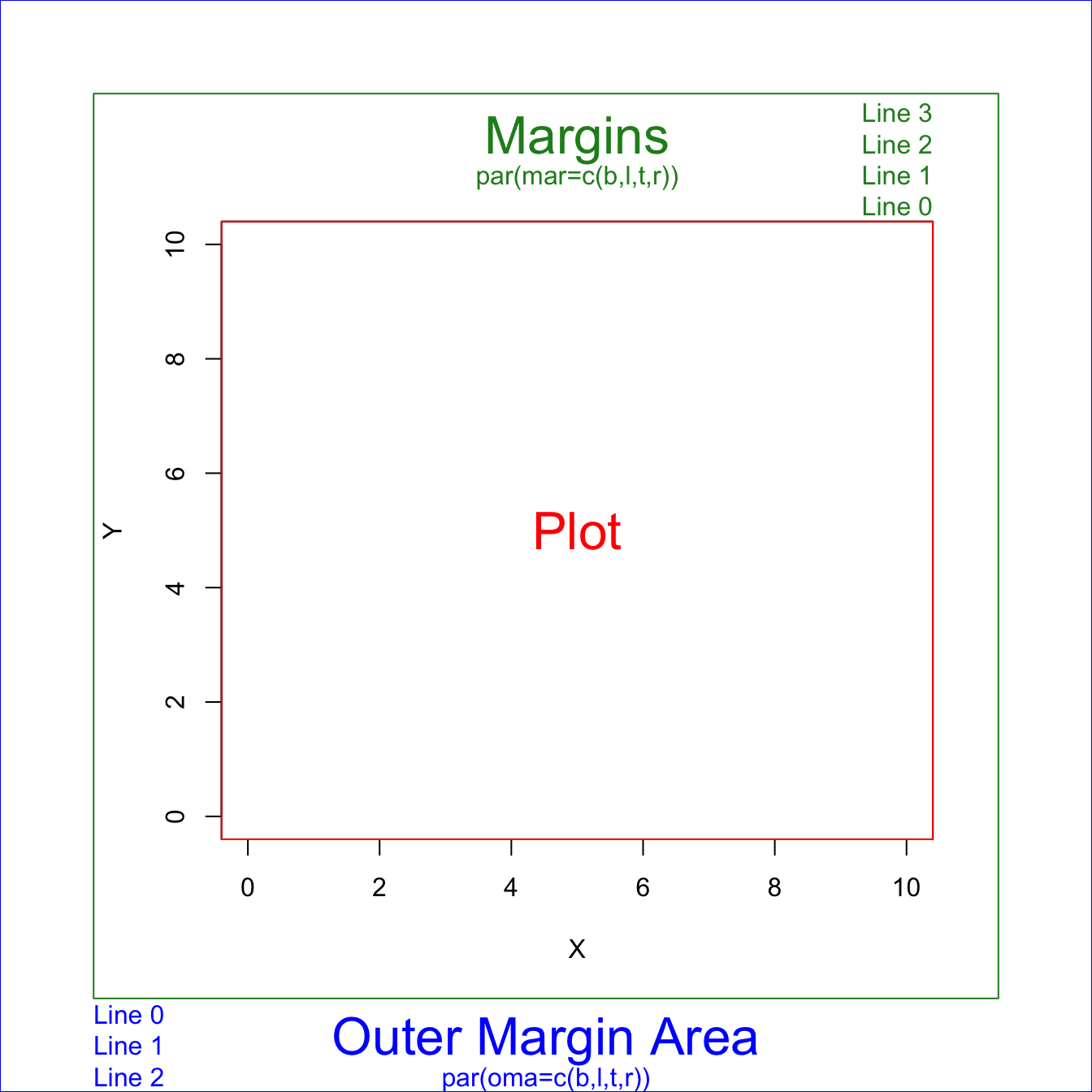4 Plots In R
Eric Fail, thank you for splom code. Unfortunately, I do not know how to run it on my data. I have 24 time series, belonging to 4 independent groups (4 Pirwise correlation plots): Frequency = 1 Min., with belonging time series AAPL1m,MSFT1m,INTC1m,FB1m,MU1m,IBM1m. Beyond just making a 1-dimensional density plot in R, we can make a 2-dimensional density plot in R. Be forewarned: this is one piece of ggplot2 syntax that is a little 'un-intuitive.' Df - tibble(xvariable = rnorm(5000), yvariable = rnorm(5000)) ggplot(df, aes(x = xvariable, y = yvariable)) + statdensity2d(aes(fill =.density.), contour. 5.4 Control the size of plots/images. The size of plots made in R can be controlled by the chunk option fig.width and fig.height (in inches). Equivalently, you can use the fig.dim option to specify the width and height in a numeric vector of length 2, e.g., fig.dim = c(8, 6) means fig.width = 8 and fig.height = 6.These options set the physical size of plots, and you can choose to display a.
- 4 Quadrant Plot In R
- 4 Diagnostic Plots In R
- 4 Dimensional Plots In R
- 4 Plot In R
- Plot 4 Variables In R
- 4 Marla Plot In Rawalpindi
In this article, you will learn to use par() function to put multiple graphs in a single plot by passing graphical parameters mfrow and mfcol.
Find plots and land for Sale in DHA 11 Rahbar Phase 4 Lahore through Zameen.com, Pakistan's largest website for plots.

 Sometimes we need to put two or more graphs in a single plot.
Sometimes we need to put two or more graphs in a single plot.R par() function
We can put multiple graphs in a single plot by setting some graphical parameters with the help of par() function. R programming has a lot of graphical parameters which control the way our graphs are displayed.
The par() function helps us in setting or inquiring about these parameters. For example, you can look at all the parameters and their value by calling the function without any argument.
You will see a long list of parameters and to know what each does you can check the help section ?par. Here we will focus on those which help us in creating subplots.
Graphical parameter mfrow can be used to specify the number of subplot we need.
It takes in a vector of form c(m, n) which divides the given plot into m*n array of subplots. For example, if we need to plot two graphs side by side, we would have m=1 and n=2. Following example illustrates this.
This same phenomenon can be achieved with the graphical parameter mfcol.
The only difference between the two is that, mfrow fills in the subplot region row wise while mfcol fills it column wise.
Same plot with the change par(mfcol = c(2, 2)) would look as follows. Note that only the ordering of the subplot is different.
More Precise Control

The graphical parameter fig lets us control the location of a figure precisely in a plot.
We need to provide the coordinates in a normalized form as c(x1, x2, y1, y2). For example, the whole plot area would be c(0, 1, 0, 1) with (x1, y1) = (0, 0) being the lower-left corner and (x2, y2) = (1, 1) being the upper-right corner.
Note: we have used parameters cex to decrease the size of labels and mai to define margins.
The numbers assigned to fig were arrived at with a hit-and-trial method to achieve the best looking plot.
- PREVIOUS
R Plot Function - NEXT
Saving a Plot in R
Introduction

This is the tenth post in the series Data Visualization With R. In the previous post, we learnt how to add text annotations to plots. In this post, we will learn how to combine multiple plots. Often, it is useful to have multiple plots in the same frame as it allows us to get a comprehensive view of a particular variable or compare among different variables. The Graphics package offers two methods to combine multiple plots. par() can be used to set graphical parameters regarding plot layout using the mfcol and mfrow arguments. layout() serves the same purpose but offers more flexibility by allowing us to modify the height and width of rows and columns.
par() allows us to customize the graphical parameters(title, axis, font, color, size) for a particular session. For combining multiple plots, we can use the graphical parameters mfrow and mfcol. These two parameters create a matrix of plots filled by rows and columns respectively. Let us combine plots using both the above parameters.
| Option | Description | Arguments |
|---|---|---|
| mfrow | Fill by rows | Number of rows and columns |
| mfcol | Fill by columns | Number of rows and columns |
mfrow combines plots filled by rows i.e it takes two arguments, the number of rows and number of columns and then starts filling the plots by row. Below is the syntax for mfrow.
Let us begin by combining 4 plots in 2 rows and 2 columns:
Libraries, Code & Data
All the data sets used in this post can be found here and code can be downloaded from here.
Case Study 1
Let us begin by combining 4 plots in 2 rows and 2 columns. The plots will be filled by rows as we are using the mfrow function:
Case Study 2
Combine 2 plots in 1 row and 2 columns.
Case Study 3
Combine 2 plots in 2 rows and 1 column.
Case Study 4
Combine 3 plots in 1 row and 3 columns.
Case Study 5
4 Quadrant Plot In R
Combine 3 plots in 3 rows and 1 column.
mfcol
mfcol combines plots filled by columns i.e it takes two arguments, the number of rows and number of columns and then starts filling the plots by columns. Below is the syntax for mfrow:
Let us begin by combining 4 plots in 2 rows and 2 columns:
Case Study 6
Combine 3 plots in 3 rows and 1 column.
Special Cases
What happens if we specify lesser or more number of graphs? In the next two examples, we will specify lesser or more number of graphs than we ask the par() function to combine. Let us see what happens in such instances:
Case 1: Lesser number of graphs specifiedWe will specify that 4 plots need to be combined in 2 rows and 2 columns but provide only 3 graphs.

Case 2: Extra graph specifiedWe will specify that 4 plots need to be combined in 2 rows and 2 columns but specify 6 graphs instead of 4.
Case Study 8
Layout
At the core of the layout() function is a matrix. We communicate the structure in which the plots must be combined using a matrix. As such, the layout function is more flexible compared to the par() function.
| Option | Description | Value |
|---|---|---|
| matrix | matrix specifying location of plants | matrix |
| widths | width of columns | vector |
| heights | height of rows | vector |
Let us begin by combining 4 plots in a 2 row/2 column structure. We do this by creating a layout using the matrix function.
Case Study 1
Combine 4 plots in 2 rows/2 columns filled by rows.
Case Study 2
4 Diagnostic Plots In R
Combine 4 plots in 2 rows/2 columns filled by columns
To fill the plots by column, we specify byrow = FALSE in the matrix.
Case Study 3
Combine 3 plots in 2 rows/2 columns filled by rows
The magic of the layout() function begins here. We want to combine 3 plots and the first plot should occupy both the columns in row 1 and the next 2 plots should be in row 2. If you look at the matrix below, 1 is specified twice and since the matrix is filled by row, it will occupy both the columns in the first row. Similarly the first plot will occupy the entire first row. It will be crystal clear when you see the plot.
Case Study 4
Combine 3 plots in 2 rows/2 columns filled by rows
The plots must be filled by rows and the third plot must occupy both the columns of the second row while the other two plots will be placed in the first row. The matrix would look like this:
Case Study 5
Combine 3 plots in 2 rows/2 columns filled by columns
The plots must be filled by columns and the first plot must occupy both the rows of the first column while the other two plots will be placed in the second column in two rows. The matrix would look like this:
Case Study 6
4 Dimensional Plots In R
Combine 3 plots in 2 rows/2 columns filled by columns
The plots must be filled by columns and the first plot must occupy both the rows of the second column while the other two plots will be placed in the first column in two rows. The matrix would look like this:
Widths
In all the layouts created so far, we have kept the size of the rows and columns equal. What if you want to modify the width and height of the columns and rows? The widths and heights arguments in the layout() function address the above mentioned issue. Let us check them out one by one: The widths argument is used for specifying the width of the columns. Based on the number of columns in the layout, you can specify the width of each column. Let us look at some examples.
Case Study 7
Width of the 2nd column is twice the width of the 1st column
Case Study 8
Width of the 2nd column is twice that of the first and last column
Heights
4 Plot In R
The heights arguments is used to modify the height of the rows and based on the number of rows specified in the layout, we can specify the height of each row.
Plot 4 Variables In R
Case Study 9
Height of the 2nd row is twice that of the first row
4 Marla Plot In Rawalpindi
Putting it all together…
Before we end this section, let us combine plots using both the widths and heights option